A quality gallery marketer published a podcast I listened to just this past week. The teaser? ‘Three things not to talk about (if you want to sell your art)’. Here’s the short version: never talk about politics, religion or sports. This guy is good, and I respect his advice; but the funny part is, I had just that morning posted an opinion piece on my personal facebook page. I decided to leave it there, as there is so much mud in the waters now politically, and the op-ed writer I shared was shining some light on a certain subject. It didn’t take long before another artist friend of mine (who sells very well) posted an alternate view to the article I liked under mine. I appreciated her viewpoint; it gave some important info. But haunting me was the echo of several who’ve instructed me “don’t get political” so, I did the more sober thing and deleted the entire post. Politics has shown its complete unreliability, and so I’ll stay mum on that score.
I’m reminded of advice given my husband and I years ago. We were in our young 20’s, and taking our summer job boss out to dinner to thank him. He was a pleasant man, maybe several decades older than us. We were from the era of campus political demonstrations and new in our spiritual convictions. To us: ‘if you care about someone, you talk about what is most important to you.’ He tried to give us advice (which we did not take): “There are two things you never talk about: religion or politics”. People said something like that a lot in the 1950’s. I remember quietly imagining how boring if conversations could never wrestle with such things.
Now I’m older than that boss was then. Now I am learning new tricks and living in a very different, even more divisive time. And one of those taboo subjects (according the gallery marketer) is what moves me to work! I certainly will talk about what moves my work and my every aim. Life has exposed politics as simply the maneuvers and manipulations of men on other men. And religion of every stripe is simply the same attempted upward. What moves me however is how the Creator of each and every man and woman is still speaking. He enters in.
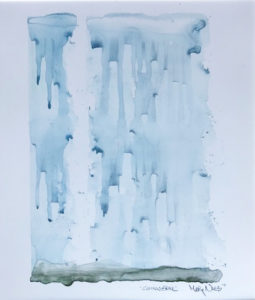 The advantage I have doing art is that I can “tell it slant” as Emily Dickinson used to say. There is no muzzle on when the work sings with beauty on its own. Makoto Fujimura explains it: “Art is an inherently hopeful act, an act that echoes the creativity of the Creator. Every time an architect imagines a new building, an artist envisions that first stroke of a brush on a white canvas, a poet seeks a resonant sound in words, or a choreographer weaves a pause in layers of movements, that act is done in hope; the creator reaches out in hope to call the world into that creation.” –Refractions (NavPress, 2009), 68.
The advantage I have doing art is that I can “tell it slant” as Emily Dickinson used to say. There is no muzzle on when the work sings with beauty on its own. Makoto Fujimura explains it: “Art is an inherently hopeful act, an act that echoes the creativity of the Creator. Every time an architect imagines a new building, an artist envisions that first stroke of a brush on a white canvas, a poet seeks a resonant sound in words, or a choreographer weaves a pause in layers of movements, that act is done in hope; the creator reaches out in hope to call the world into that creation.” –Refractions (NavPress, 2009), 68.
No deletions have to be considered when the work gently vibrates into even the harshest of times. Art speaks, and best when it is responding to the original initiator. It beckons and invites. And you can walk away without feeling like you’ve been sold something you didn’t want to buy.
The artists are the ones who may be the best at talking now, for as C.S. Lewis said, they are the ones who can “steal past those watchful dragons”.

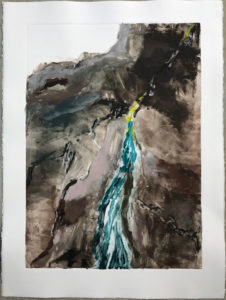
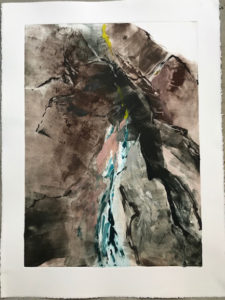 The journey of Moses leading the Hebrews out of slavery and into the land has informed some recent visual work. There’s a curious episode with water coming out of a rock that strangely happens twice:
The journey of Moses leading the Hebrews out of slavery and into the land has informed some recent visual work. There’s a curious episode with water coming out of a rock that strangely happens twice: 
 The mid 20th century Bauhaus instructor Joseph Albers was a master at helping his art students understand this. Using color chips and simple exercises, like “make five colors into six”, they learned the relativity of color. “In order to use color effectively, it is necessary to recognize that color deceives continually”, Albers said. Here is one exercise exampled. The brown squares are the same exact hue, but the reading of each is influenced by its surrounding colors. A dark context makes the center color lighter, a cool context makes the center color warmer and vice versa.
The mid 20th century Bauhaus instructor Joseph Albers was a master at helping his art students understand this. Using color chips and simple exercises, like “make five colors into six”, they learned the relativity of color. “In order to use color effectively, it is necessary to recognize that color deceives continually”, Albers said. Here is one exercise exampled. The brown squares are the same exact hue, but the reading of each is influenced by its surrounding colors. A dark context makes the center color lighter, a cool context makes the center color warmer and vice versa.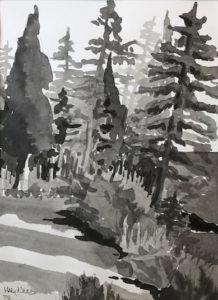

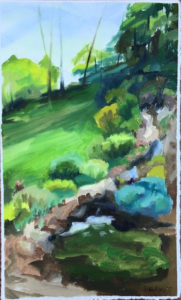 So I did a little exercise to test my “strike” resolve (see last post on the burger billboard). Abstractions made concrete, thoughts made real. The green has been shouting at me for attention, so I dug in to bring it home.
So I did a little exercise to test my “strike” resolve (see last post on the burger billboard). Abstractions made concrete, thoughts made real. The green has been shouting at me for attention, so I dug in to bring it home. I didn’t stop on the highway to photograph the strange burger-joint billboard, just thought about it for the next, oh- maybe, 30 miles. There was the standard burger, and then the exhortation to “eat like you mean it.”
I didn’t stop on the highway to photograph the strange burger-joint billboard, just thought about it for the next, oh- maybe, 30 miles. There was the standard burger, and then the exhortation to “eat like you mean it.”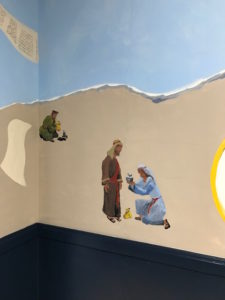 .
.



 Another friend and I worked this week on the huge mural project we started last year. It too is a continuum. It starts at the beginning of historical time and ends where the kids in the program we are serving, can look into a mirror. All along the way are emblems of the grand story, punctuated by avatars of the very kids who walk this hallway after school. We’re hoping to lift their vision even as we are lifting our own.
Another friend and I worked this week on the huge mural project we started last year. It too is a continuum. It starts at the beginning of historical time and ends where the kids in the program we are serving, can look into a mirror. All along the way are emblems of the grand story, punctuated by avatars of the very kids who walk this hallway after school. We’re hoping to lift their vision even as we are lifting our own.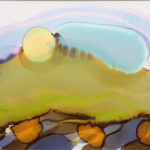 I will end the year with a simple post and a simple piece. After the workshop I taught, putting materials away, I decided to play on my own just a bit more. This one is a success and I matted it with an Emily Dickinson poem I have loved:
I will end the year with a simple post and a simple piece. After the workshop I taught, putting materials away, I decided to play on my own just a bit more. This one is a success and I matted it with an Emily Dickinson poem I have loved: